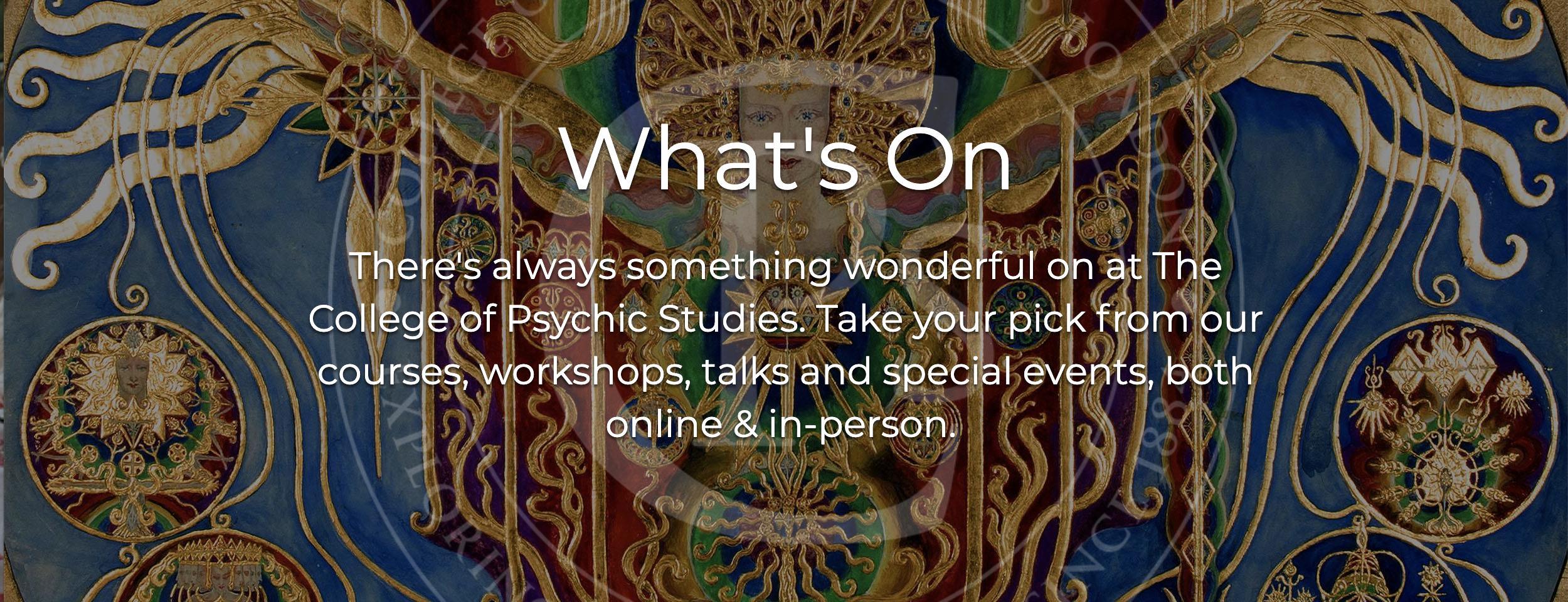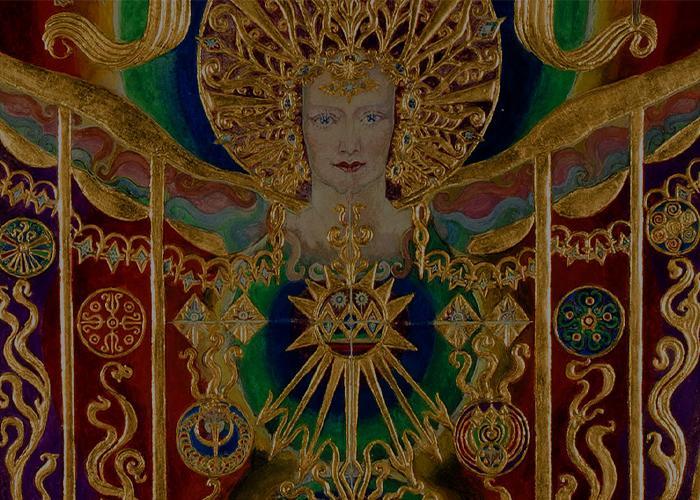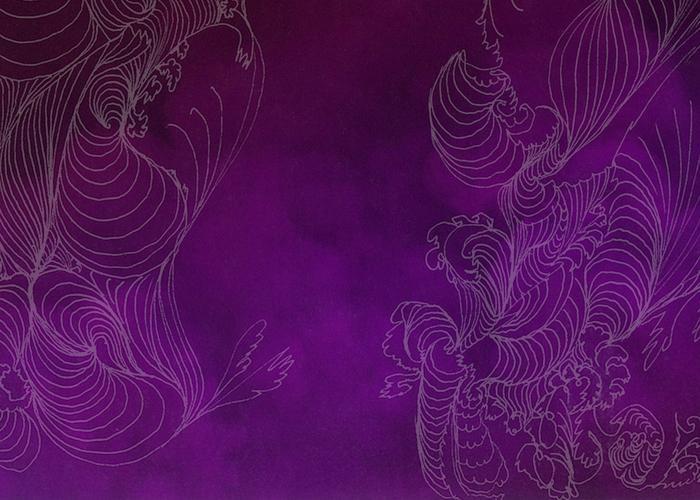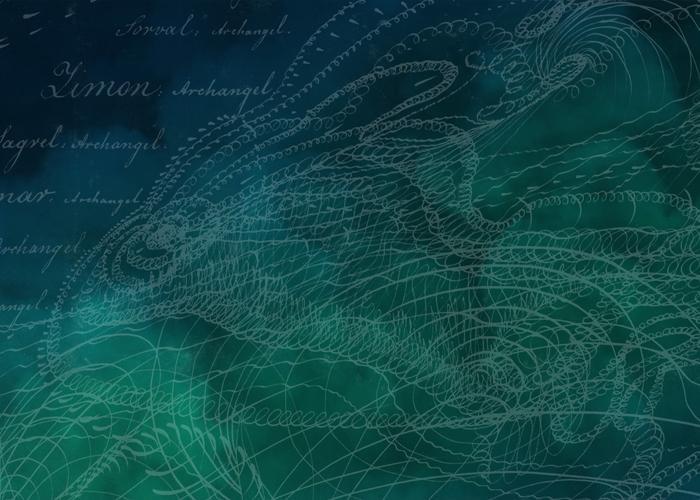When we re-introduced planetary magick to our prospectus in 2018 with the legendary Judy Hall (1943-2021), we've received increasing requests for more. Understandably, as it's a very accessible, intuitive and powerful form of intentional spiritual practice. Ahead of our online planetary magick course with Pixie P Carney, we offer some context for those who are new to this practice.
As a proviso, planetary magick is a huge subject - if you love a rabbit hole, you've found one right here! You can learn so much more in our online classes, but in the meantime, here is a summary of what planetary magick is all about, and how it can enhance your life.
A little about planetary magick...
Planetary magick works with the powerful energies associated with the celestial bodies in our solar system, namely the Sun and Moon, Venus, Jupiter, Saturn, Mercury and Mars. Each planet has its own unique energetic qualities and correspondences, which we can harness for various purposes such as healing, protection, manifestation, and spiritual growth.
In planetary magick, each planet is associated with certain archetypes, symbols, colours, metals, herbs, and even deities. In practical planetary magick, we may perform rituals, spells, and meditations that align with the specific energies of a particular planet to achieve our desired outcomes. For example, those of us seeking to enhance our communication skills might work with the energy of Mercury, while someone seeking love and harmony might work with the energy of Venus.
Astrological timing is important in planetary magic. We choose specific times or days that are astrologically aligned with the planet we are working with, depending on what we might want to achieve. This might involve performing rituals during planetary hours or on days when a particular planet is prominent in the sky.
Overall, planetary magic is a complex and multifaceted practice that draws upon the ancient belief in the interconnectedness of the cosmos and the earthly realm, seeking to tap into the vast energies of the universe to effect change in our life and surroundings.
Join our planetary magick course:

How to work with the planets in magical practice
As we mentioned, this is one rabbit hole that is impossible to comprehensively map out in a single article. For that, you will need to join our planetary magick course! However, for the sake of brevity, we offer a quick outline of what each celestial body represents:
Planetary magick of the Sun
Planetary magick of the Sun, often referred to as solar magic, involves working with the energetic qualities associated with the sun. The sun is a central and vital force in many mystical and esoteric traditions, symbolising attributes such as vitality, energy, illumination, enlightenment, and personal power. In solar magic, we align ourselves with the sun's energies to manifest goals related to vitality, success, enlightenment, and personal empowerment.
Solar magick correspondences include:
- Sun colour: Gold, yellow, and orange are often associated with the Sun due to their connections with warmth, light, and energy.
- Sun metal: Gold is considered the metal associated with the Sun, symbolising its radiant and luminous qualities.
- Sun herbs and plants: Plants such as sunflower, St. John's wort, chamomile, and cinnamon are associated with the sun.
- Sun stones: Crystals such as citrine, amber, and tiger's eye are associated with the sun.
- Sun day of the week: Sunday is considered the day of the Sun and is often chosen for solar rituals and spells.
- Sun astrological sign: The sun rules over the astrological sign of Leo. Practitioners may consider the positions of the sun in their natal charts when working with solar magic.
Practices within solar magic often involve activities that promote self-expression, confidence, and vitality. Rituals may include activities like sun salutations, visualisation exercises to connect with the sun's energy, or performing ceremonies to honour the sun and seek blessings for success and personal growth.
Overall, solar magic is a practice that encourages personal empowerment, creativity, and vitality. It's particularly beneficial for those seeking to connect with their inner light, cultivate confidence, and harness the radiant energy of the sun to manifest their goals and aspirations.
Planetary magick of the moon
Moon planetary magick, also known as lunar magic, involves working with the energetic qualities associated with the moon. The moon is a powerful symbol in many mystical and esoteric traditions, representing attributes such as intuition, emotions, cycles, mystery, and the subconscious mind.
In lunar magic, practitioners may perform rituals, spells, meditations, or other practices designed to align themselves with the moon's energies to manifest goals related to intuition, emotional healing, psychic abilities, fertility, and connecting with the subconscious.
Lunar magic correspondences include:
- Moon colour: Silver, white, and sometimes blue are often associated with the moon due to their connections with its ethereal and reflective qualities.
- Moon metal: Silver is considered the metal associated with the moon, symbolising its luminescence and connection to the night sky.
- Moon herbs and plants: Plants such as jasmine, white sage, moonflower, and mugwort are associated with the moon.
- Moon stones: Crystals such as moonstone, selenite, quartz, and pearl are associated with the moon.
- Moon day of the week: Monday is considered the day of the moon and is often chosen for lunar rituals and spells.
- Moon astrological signs: The moon rules over the astrological sign of Cancer. Practitioners may consider the positions of the moon in their natal charts when working with lunar magic.
Practices within lunar magic often involve activities that promote emotional healing, intuition, and connection with the subconscious mind. Rituals may include activities like moon-gazing, meditation on lunar phases, dreamwork, or performing ceremonies to honour the moon and seek guidance from its wisdom.
Overall, lunar magic is a practice that encourages introspection, emotional balance, and intuition. It's particularly beneficial for those seeking to connect with their inner emotions, tap into their psychic abilities, and align with the natural cycles of the moon for personal and spiritual growth.
Planetary magick of Mars
Mars planetary magic involves working with the energetic qualities associated with the planet Mars. Mars is often associated with attributes such as courage, strength, passion, action, and assertiveness in various mystical and esoteric traditions.
In Marsian magic, practitioners may perform rituals, spells, meditations, or other practices designed to align themselves with Mars's energies to manifest goals related to courage, protection, strength, victory, and overcoming obstacles.
Marsian magic correspondences include:
- Mars colour: Red is the primary colour associated with Mars due to its association with energy, passion, and vitality.
- Mars metal: Iron is considered a metal associated with Mars.
- Mars herbs and plants: Plants such as red pepper, garlic, nettle, and thistle are associated with Mars.
- Mars stones Bloodstone, garnet, and red jasper are stones and crystals associated with Mars.
- Mars day of the week: Tuesday is considered the day of Mars and is often chosen for Marsian rituals and spells.
- Mars astrological sign: Mars rules over the astrological sign of Aries and is also associated with Scorpio. Practitioners may consider the positions of Mars in their natal charts when working with Marsian magic.
Practices within Marsian magic can range from assertive and direct to disciplined and focused. They may include rituals for protection, energy work, martial arts, or other forms of physical exercise to harness and channel Mars's fiery energy.
Overall, Marsian magic is a potent and dynamic practice for those seeking to cultivate courage, strength, and the drive to pursue their goals with determination and passion. However, it's important for practitioners to approach Marsian magic with respect and caution, as Mars's energy can be intense and potentially volatile if not properly directed.
Planetary magick of Venus
Venus planetary magick involves working with the energetic qualities associated with the planet Venus. Venus is often associated with love, beauty, harmony, sensuality, creativity, and fertility in various mystical and esoteric traditions.
In Venusian magic, practitioners may perform rituals, spells, meditations, or other practices designed to align themselves with Venus's energies to manifest love, enhance relationships, cultivate self-love and self-worth, attract beauty and abundance, and stimulate creativity.
Venusian magic correspondences include:
- Venus colour: Green and pink are often associated with Venus due to their associations with growth, love, and affection.
- Venus metal: Copper is considered a metal associated with Venus.
- Herbs and plants: Roses, jasmine, yarrow, and vervain are among the herbs and plants associated with Venus.
- Venus stones: Emerald, rose quartz, and jade are stones and crystals associated with Venus.
- Venus day of the week: Friday is considered the day of Venus and is often chosen for Venusian rituals and spells.
- Venus astrological sign: Venus rules over the astrological signs of Taurus and Libra, and practitioners may consider the positions of Venus in their natal charts when working with Venusian magic.
Practices within Venusian magic can vary widely, ranging from simple rituals such as lighting candles or creating altars dedicated to Venus, to more elaborate ceremonies involving invocations, offerings, and visualisations. The intention behind Venusian magic is typically to cultivate love, beauty, harmony, and pleasure in one's life and relationships.
Overall, Venusian magic is a deeply enriching and rewarding practice for those seeking to enhance their connections with love, beauty, and the finer aspects of life.
Planetary magick of Mercury
Mercury planetary magick involves working with the energetic qualities associated with the planet Mercury. Mercury is often associated with attributes such as communication, intellect, wit, travel, commerce, and adaptability in various mystical and esoteric traditions.
In Mercurial magic, practitioners may perform rituals, spells, meditations, or other practices designed to align themselves with Mercury's energies to manifest goals related to communication, learning, commerce, problem-solving, and mental agility.
Mercurial magic correspondences include:
- Mercury colour: Yellow is often associated with Mercury due to its connection with intellect and communication.
- Metal: Mercury is, of course, associated with the metal mercury, but due to its toxic nature, other metals like silver are sometimes used as alternatives.
- Herbs and plants: Plants such as lavender, peppermint, fennel, and parsley are associated with Mercury.
- Stones: Crystals such as clear quartz, citrine, and fluorite are associated with Mercury.
- Day of the week: Wednesday is considered the day of Mercury and is often chosen for Mercurial rituals and spells.
- Astrological signs: Mercury rules over the astrological signs of Gemini and Virgo. Practitioners may consider the positions of Mercury in their natal charts when working with Mercury magic.
Practices within Mercury magic often involve activities that stimulate the mind and facilitate communication, such as writing, studying, brainstorming, or engaging in conversations. Rituals may include activities like writing spells or affirmations, creating sigils, or performing ceremonies to honor Mercury's influence.
Overall, Mercury magic is a versatile and intellectually stimulating practice that can enhance communication skills, mental clarity, and adaptability. It's particularly beneficial for those seeking to improve their communication abilities, expand their knowledge, or overcome obstacles through creative problem-solving.
Planetary magic of Saturn
Saturn planetary magic involves working with the energetic qualities associated with the planet Saturn. Saturn is often associated with attributes such as discipline, responsibility, structure, wisdom, perseverance, and limitation in various mystical and esoteric traditions.
In Saturnian magic, practitioners may perform rituals, spells, meditations, or other practices designed to align themselves with Saturn's energies to manifest goals related to discipline, long-term planning, overcoming obstacles, achieving goals, and spiritual growth through self-discipline.
Saturnian magic correspondences include:
- Colour: Black and dark blue are often associated with Saturn due to their connection with seriousness and depth.
- Metal: Lead is considered a metal associated with Saturn.
- Herbs and plants: Plants such as cypress, comfrey, mullein, and Solomon's seal are associated with Saturn.
- Stones: Crystals such as onyx, obsidian, hematite, and black tourmaline are associated with Saturn.
- Day of the week: Saturday is considered the day of Saturn and is often chosen for Saturnian rituals and spells.
- Astrological signs: Saturn rules over the astrological signs of Capricorn and Aquarius. Practitioners may consider the positions of Saturn in their natal charts when working with Saturn magic.
Practices within Saturn magic often involve activities that promote discipline, introspection, and long-term planning. Rituals may include activities like grounding exercises, meditation on the passage of time, or performing ceremonies to honor Saturn's influence and seek guidance in matters related to structure and discipline.
Overall, Saturn magic is a practice that encourages patience, perseverance, and self-discipline. It's particularly beneficial for those seeking to overcome challenges, achieve long-term goals, and cultivate inner strength and wisdom through disciplined effort and introspection.
Planetary magic of Jupiter
Jupiter planetary magic involves working with the energetic qualities associated with the planet Jupiter. Jupiter is often associated with attributes such as expansion, growth, abundance, wisdom, generosity, and opportunity in various mystical and esoteric traditions.
In Jovian magic, practitioners may perform rituals, spells, meditations, or other practices designed to align themselves with Jupiter's energies to manifest goals related to prosperity, success, personal growth, luck, and spiritual expansion.
Jupiter magic correspondences include:
- Colour: Deep purple, royal blue, and sometimes gold are often associated with Jupiter due to their connections with abundance and royalty.
- Metal: Tin is considered a metal associated with Jupiter.
- Herbs and plants: Plants such as cinnamon, nutmeg, sage, and bay laurel are associated with Jupiter.
- Stones: Crystals such as amethyst, citrine, and lapis lazuli are associated with Jupiter.
- Day of the week: Thursday is considered the day of Jupiter and is often chosen for Jovian rituals and spells.
- Astrological signs: Jupiter rules over the astrological signs of Sagittarius and Pisces. Practitioners may consider the positions of Jupiter in their natal charts when working with Jupiter magic.
Practices within Jupiter magic often involve activities that promote optimism, generosity, and expansion. Rituals may include activities like gratitude rituals, visualisation exercises for abundance, or performing ceremonies to honour Jupiter's influence and seek blessings for prosperity and growth.
Overall, Jupiter magic is a practice that encourages optimism, generosity, and abundance consciousness. It's particularly beneficial for those seeking to expand their horizons, attract opportunities, and cultivate a sense of gratitude and abundance in their lives.
A potted history of planetary magick
The origins of planetary magick can be traced back to ancient Mesopotamia, Egypt, Greece, and Rome. These cultures observed the movements of celestial bodies and developed elaborate systems of astrology and cosmology, which included attributing specific qualities and influences to the planets.
One of the earliest known texts on planetary magick is the Picatrix, an Arabic grimoire (aka Ghāyat al-Ḥakīm) written sometime in the 10th or 11th century, possibly based on earlier Greek or Persian sources. The Picatrix outlines rituals, spells, and correspondences for working with the energies of the planets for various magical purposes. It was later translated into Latin and became influential in medieval European occultism.
During the Renaissance, interest in astrology and magic experienced a revival, and scholars such as Marsilio Ficino and Cornelius Agrippa incorporated planetary magick into their mystical and philosophical writings. They synthesised elements of ancient knowledge with Christian theology and Hermeticism, contributing to the development of ceremonial magic traditions that included planetary invocations and rituals.
In the 19th and 20th centuries, the occult revival led to a resurgence of interest in planetary magick among various esoteric and magical traditions, including Hermeticism, Thelema, and modern witchcraft. Today, planetary magick continues to be practiced by individuals and groups within various occult and magical communities around the world - including many students at The College of Psychic Studies.
Overall, the history of planetary magick is deeply intertwined with the evolution of human understanding of the cosmos, astrology, and the esoteric traditions of different cultures, evolving over millennia into the diverse and multifaceted practice it is today.
How to learn planetary magick
Planetary magick is a process of learning, and we recommend you find a good teacher to support your learnings. Dr Vivianne Crowley offers online planetary magic masterclasses at The College of Psychic Studies, and don't miss Pixie P Carney's 8-week online planetary magick course.

Join our newsletter to keep connected with The College of Psychic Studies.




